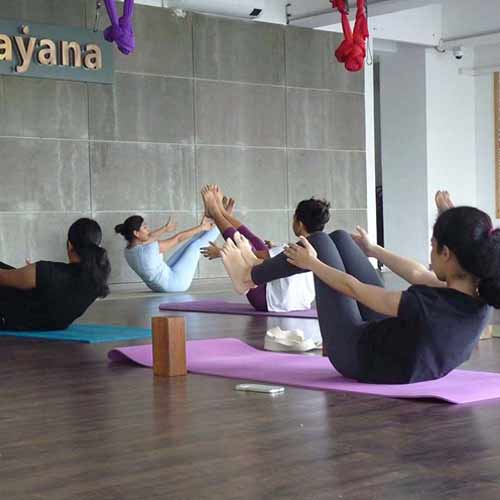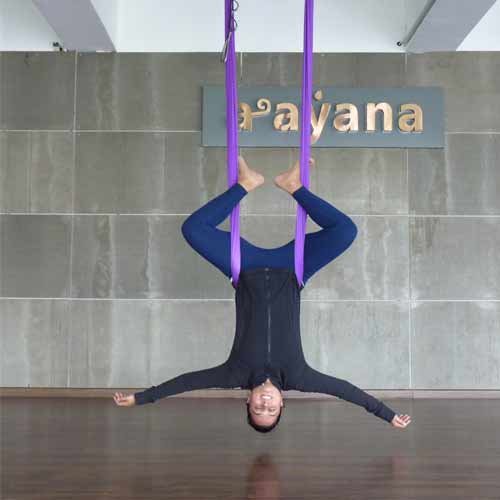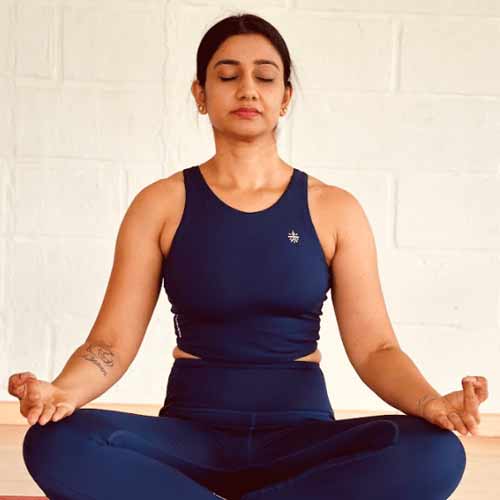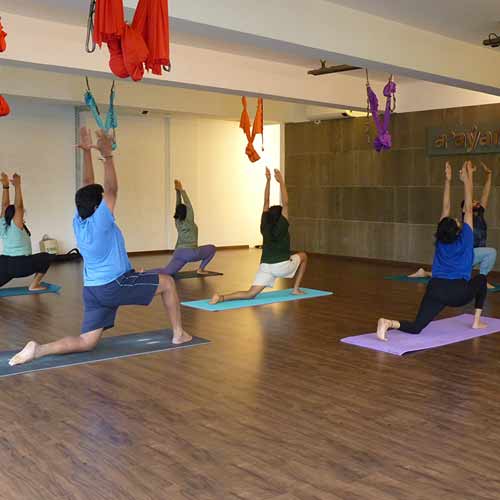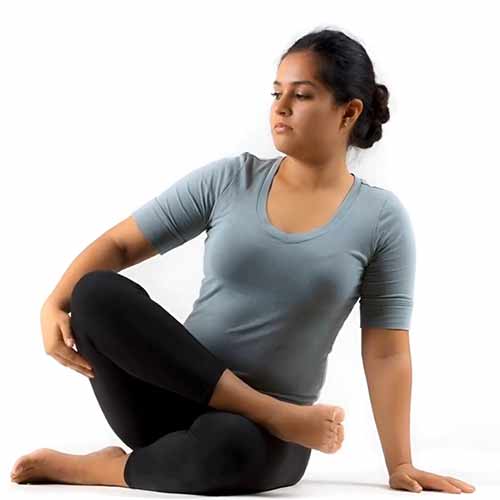HATHA YOGA – THE CLASSICAL WAY

The main purpose of Yoga is to clear the mind of its disturbances so as to lead oneself to a tranquil state. Control of the mind is achieved by balancing opposing energies that flow through us.. By adopting postures that help create focus on ‘Ha’ (prana) and ‘Tha’ (apana) forms the prime element of Hatha Yoga. Hence, a Hatha Yoga session will be characterised by stillness in asanas rather than continuous movements. B.K.S. Iyengar, one of the foremost proponents of Yoga to the world defines’ Ha’ as the Sun or the Soul and ‘Tha’ as Moon or Consciousness. Yoking these two is possible by stilling the constantly shifting mind which is what execution of Hatha Yoga is all about.
Characteristics of hatha yoga
Walk into a Hatha Yoga class and expect to hold your asanas for a while. Every asana requires you to be motionless with dedicated focus on your breath. As the revered master B.K.S. Iyengar puts it – In controlling the breath you are controlling consciousness, and by controlling consciousness you bring rhythm to the breath. This, in short, forms the foundation of Hatha Yoga practice, What emerges is manifold benefits, the most subtle and primary being purging the body of its toxicity and uncoiling of Pranic energy.
The ultimate aim of Hatha Yoga is to achieve optimum health and harmonize energy flow and it works towards this goal with discipline and will- power. Though it may appear that Hatha Yoga is all about steadfastness of body and breath, it encompasses many other parts. These include Shatkarmas or cleansing processes,Asanas or physical postures, Mudras or symbolic hand gestures, Pratyahara or withdrawl of sensory projections, Pranayama or breathing exercises to add dimensions to pranic energy, Dhyana or Meditation and Samadhi or Equanimity through elimination of thought.leading to self realization.
A true Hatha yogi has to incorporate these elements as a holistic process of realising the purpose of Yoga.

Hatha yoga teacher
Nothing can replace the inspiration and guidance that a qualified teacher can bring to those aspiring to reap the rich benefits of Hatha Yoga. It is of vital importance therefore, for a Hatha Yoga instructor to possess in-depth knowledge about Hatha Yoga Postures, Yoga Philosophy, Anatomy, Alignments, Sequencing, Adjustments and Modifications which will ensure a safe and beneficial implementation of this particular form of Yoga. Bearing in mind the fact that Hatha Yoga lays down a firm foundation to explore every other school of Yoga, it needs to be stressed that one who undertakes the highly respected task of a Guru should be equipped with a Teacher’s Training Course that is painstakingly thorough in every aspect.
Some Hatha yoga positions
To One can build up a Hatha Yoga practice by taking on basic postures or asanas under the guidance of an experienced teacher. Hatha Yoga positions commonly presented in a Hatha Yoga class will include:
Inversions / Seated Postures / Standing Postures / Balancing Postures / Supine or Lying down Postures / Back Bends /
Why Hatha is so popular ?
Denoting a common nomenclature for most forms of Yoga practiced all over the world including Restorative Yoga, Power Yoga, Ashtanga, Iyengar and Bikram Yoga, Hatha yoga in the world has emerged as the ideal practice process for beginners aspiring to do yoga. It finds humongous number of followers in almost all countries and its popularity keeps increasing. since it lays a firm foundation from which to explore the vastness of Yoga universe.Immensely suited to any age, gender or race that seeks to reap its rich benefits, Hatha Yoga provides a gentle format to get to know the right way to practice Yoga and to adopt a Yogic lifestyle.
Hatha Yoga rates itself on par with popular exercise formats such as Tai Chi or Pilates due to its excellence methodology of connecting body, breath and mind. Not only has Hatha Yoga practice been linked to physical health benefits in people suffering from cancer, asthma, spine conditions,fibromyalgia, carpal tunnel syndrome, it has proved itself to be an effective antidote for stress reduction and deep relaxation. It endows strength, flexibility and balance and helps heal deep seated ailments. Consistent adherence to a systematic routine definitely can be life changer where Hatha Yoga is concerned.
Interestingly, contemporary Yoga schools have introduced Hatha Yoga Flow practice that seamlessly draws out the stillness associated with Hatha Yoga into a rhythmic flow or vinyasa. Conjoining various asanas into a meaningfully constructive sequence has emerged a new-age variation of traditional Hatha Yoga practice. A Hatha Yoga presentation brings forth the different components of a practice session. One gets to know the graceful combination of strength and flexibility that goes into executing this venerated form of Yoga gifted to us across centuries.
Hatha for health
Remaining steady in a Yoga posture for a considerable period of time necessitates paying attention to the right alignment in order to avoid injuries or pain, Hatha Yoga practice makes one aware of the right way to move into an asana and stay with it. Consistent practice soon leads to enhanced fitness levels as well as a well- proportioned body endowed with grace and balance. Practicing Hatha Yoga is good for health. Hatha has been known to alleviate spine conditions and get rid of hypertension and arthritis.
Hatha for all ages
The best thing about taking up Hatha Yoga is for all ages and it easy adaptiveness. There are no detrimental factors when it comes to stepping into this fitness arena at any age. In fact, Hatha Yoga helps in restoring vitality and health irrespective of the practitioner’s age. The advantage lies in the various forms designed for those of different levels of fitness and vigor.
Join now a yoga class at Aayana yoga Academy: Vinyasa, Aerial, Meditation, Hatha, Yin, Nidra, Pranayama, Mudgar, High-Intensity, Gentle flow, Power yoga, Ashtanga yoga, Kids yoga …
Ashtanga Yoga
Ashtanga Yoga Eight Limbed Path of Transformation rooted in ancient tradition A dynamic practice by…
Power Yoga Class
POWER YOGA – TRANSFORM YOUR BODY Power up your yoga practice: Power up your yoga…
Mudgar Yoga
MUDGAR A COMPLETE GUIDE Exercises, Benefits, Symbolism Traditional Indian mace Physical trainingThe Mudgar (मुद्गर), a traditional Indian…
Aerial Yoga Class
AERIAL YOGA CLASS – YOGA THAT DEFIES GRAVITY strengthen mid-air Who could attend Aerial yoga?…
Gentle Flow Yoga
STRETCH & BREATHE IN GENTLE YOGA the calm side to Yoga The way to be…
Kids Yoga Class
YOGA FOR CHILDREN Growing Minds Where Play Meets Inner Peace A trending practiceSchools and parents…
Pranayama Class
PRANA YOGA FOR HEALTHY MIND FOR HEALTHY BODy Prana adding dimensions to life force The…
Meditation
MEDITATION – THE PERFECT TECHNIQUE FOR MINDFUL AWARENESS Dharana Single minded focus Stilling the mindReaching…
Vinyasa Yoga Class
FLOW WITH VINYASA YOGA Vinyasa yoga class flow from one to another Vinyasa one breath…
Yoga Nidra Class
NIDRA YOGA – FLOATING AWAKE YOGA NIDRA like a leaf Yoga Nidra Or Yogic Sleep Guided…
Yin Yoga Class
YIN YOGA – THE INTROSPECTIVE SIDE OF YOGA BANGALORE ACADEMY YIN REPRESENTS PASSIVE FEMININE MOON…


